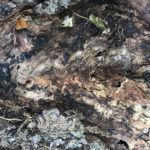I was away during the summer and when I returned, two weeks ago, I noticed that a crabapple tree on my front lawn (Leaside) has little foliage (it was normal in May) and the trunk has holes in it made by some pests. Our neighbors’ crabapple tree looks poorly as well and I noticed a couple of crabapple trees in the same condition while walking in Rosedale. No other trees seem to be affected in the same way. I contacted the city but I love my tree and maybe you can recommend some course of actions that would help it get better? Photos are attached. Thank you in advance for your help.
Thank you for contacting the Toronto Master Gardeners about your ailing crabapple tree.
Crab apple is susceptible to a number of diseases which can harm the tree – Apple scab fungus (Venturia inaequalis) and Fire blight bacteria (Erwinia amylovora) are just two.
From your photo it appears that your tree is covered in a black gummy substance which could be an indication of fire blight. According to The Ministry of Agriculture and Rural Affairs (OMAFRA) “Fire blight attacks many different parts of the tree, and fire blight symptoms are often referred to the part of the tree attacked – blossom, shoot, fruit, limb and trunk, and collar or rootstock blight.”
The following is a description of trunk blight from OMAFRA’s website: Fire Blight
Limb and trunk blight
The most severe losses from both blossom and shoot blight occur when the disease progresses into older wood. Fire blight progresses into the main limbs and trunk of the tree from infected spurs or shoots when warm temperatures with high humidity combine to form ideal conditions for fire blight. The cankers that form in the older wood girdle the branch, killing healthy wood from that point outward by cutting off the transport of nutrients and water. The cankers first appear brown to purple in colour. Eventually they become sunken with cracked margins (Figure 4-158). The tissue under the bark initially appears water soaked, eventually with red streaks and finally turns brown. During rainy or very humid periods, bacteria ooze onto the surface of the cankers. At first, bacterial ooze appears a milky white drop but quickly becomes brown upon exposure to air. The ooze dries out and remains as a gummy substance or completely dries to an amber resin-like substance on canker surfaces where it remains for several months. The bacteria in the ooze act as source of inoculum that is spread to other tissues or trees by visiting insects and splashing rain during wet periods. Bacteria are also easily spread from tree to tree on contaminated pruning tools. In the winter, cankers usually dry up and become inactive. In the spring, renewed activity at the margins of cankers results in the extension of the cankers. Infections extend and spread into adjacent water sprouts, shoots and limbs resulting in canker blight. Canker extension may begin before, during or shortly after bloom, depending on the environmental conditions experienced during the spring in the orchard.
It is difficult to exactly determine from the photo if the exact cause of your tree’s decline is strictly fire blight/ trunk blight or a combination of fungi. There is also a possibility that your tree was attacked by borer insects. Are the holes that you are seeing near the base of the trunk? Do you see any evidence of sawdust at the bottom of the holes? If this is the case then it could be that you have a type of borer infecting your tree. There are various kinds of borers that can impact crabapples, apple-bark borer being just one type of pest. The following website from OMAFRA gives various descriptions for different type of Apple Borers.
My advice would be to contact a certified arborist. He will be able to determine if your tree is suffering from a fungal attack or an insect pest and what will be the best course of treatment.
To find a certified professional arborist to help you with a tree problem, visit the Ontario branch of the International Society of Arboriculture here.


